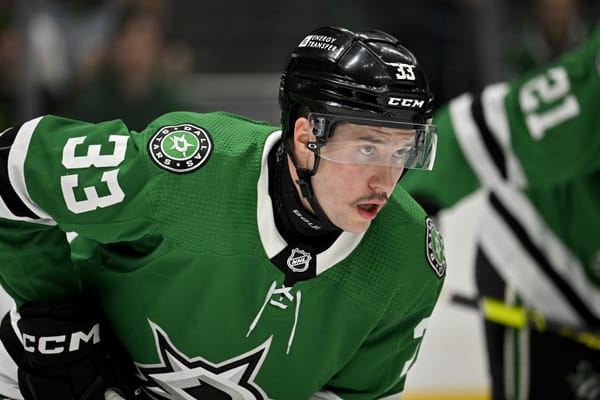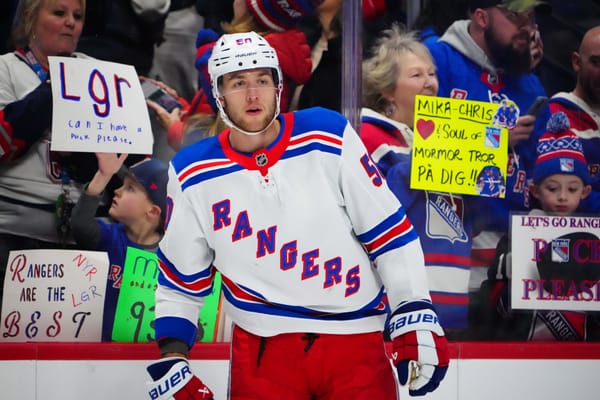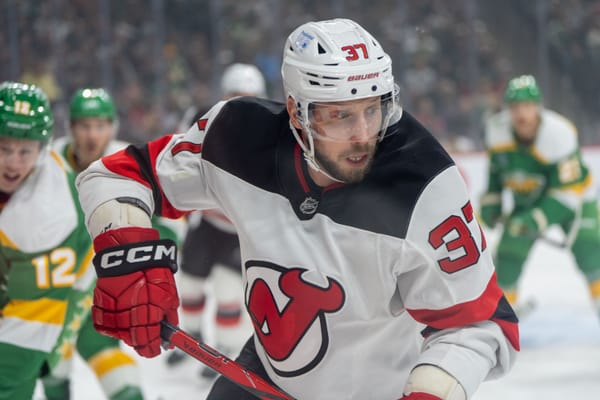Rangers’ Kids Need More Ice Time
In the long term, to develop further. But more immediately, to help the Rangers continue to win in these playoffs.
The New York Rangers’ kids need more time. Yes, they still need more time to fully develop and hit the ceilings of their potential. But they’re already very effective in the current stages of their development. As such, in what has become a very exciting short term, they also need more time — on the ice, for a Rangers team that holds a 2-1 series lead in the Eastern Conference Final over the Tampa Bay Lightning.
The Kids Are Growing Up in the Playoffs
For purposes of this article, the term “kids” specifically refers to the now well-known “Kid Line” of Alexis Lafrenière, Filip Chytil, and Kaapo Kakko — all of whom are under 23 years old. The trio has played together for most of this postseason after minimal time together in the regular season, and the results have been about as good as the Rangers could have hoped for.
They’ve chipped in points (2-7-9 for Lafrenière, 7-2-9 for Chytil, and 2-3-5 for Kakko) while also outperforming all other Rangers forwards in terms of expected goal share (xGF%) at five-on-five. Chytil leads the team with an xGF% of 53.27 percent at five-on-five in the postseason. Put simply, the Rangers generate more high-quality chances than the opponent when he’s on the ice versus when he isn’t. Kakko is right behind him at 50.17 percent, while Lafrenière is third among forwards at 48.38 percent. (Yes, these numbers are still pretty ugly for most of the team as they recover from some very rough games against the Pittsburgh Penguins in the first round.)
The Shift, in its entirety.
— New York Rangers (@NYRangers) June 2, 2022
The kids. 👏👏👏 pic.twitter.com/ymMs6E3JrC
Those numbers have been even better for each player in the current series against the Lightning. In the three games, Lafrenière leads the team with an astounding xGF% of 65.37 percent at five-on-five. Chytil is second with a mark of 63.15 percent, and Kakko is third at 62.80 percent. No one else is above 50 percent. Below is a good illustration from Evolving Hockey; even though this particular chart shows Corsi (i.e., shot attempts) for and against in Game 2 against the Lightning, it tells the same story. The kids are in a tier of their own.
The Kid Line is special pic.twitter.com/5YvJVJj3iV
— Evolving-Hockey (@EvolvingHockey) June 4, 2022
The kids are also getting the scoresheet results in this series; Chytil has two goals and an assist, Lafrenière has two assists, and Kakko has a goal and an assist.
So, Why Aren’t The Kids Playing More?
Why indeed. Despite their exciting and effective play, the Kid Line has not received a high level of ice time throughout the playoffs — especially so far in the Eastern Conference Final. It’s probably standard head coaching tendencies to lean more on veterans. In any event, at five-on-five, Lafrenière has seen an average of 12:41 of ice time per game. Among forwards appearing in at least five postseason games for the Rangers, that leads only Chytil (12:06), Barclay Goodrow (11:54; his time in Game 1 against the Penguins was also cut short by injury), Kakko (11:32), Tyler Motte (10:39), Kevin Rooney (10:17), and Ryan Reaves (8:31).
In the Eastern Conference Final, each player has seen even less time at five-on-five: Chytil is averaging 11:37, Kakko 10:24, and Lafrenière only 10:19; only Reaves (9:15) has seen less time than Kakko and Lafrenière. Yes, these numbers are a bit skewed by a Game 3 which saw quite a bit of non-five-on-five time, but Artemiy Panarin and Andrew Copp, for instance, are both averaging over 15 minutes of five-on-five ice time per game. Mika Zibanejad is at over 14 minutes per game, Frank Vatrano over 13 minutes, and Chris Kreider and Ryan Strome (who left Game 3 early with an injury) each over 12 minutes. Since many of these players see a ton of time on special teams in addition to even strength, it would behoove head coach Gerard Gallant to find more opportunities for the kids at even strength, since they won’t have much else besides some scant time on the second power-play unit.
Creating Matchup Problems
Part of the reason why top players like Zibanejad and Kreider do not have nearly as good underlying even-strength metrics as the Kid Line is because of opposing teams matching up their best lines, or their best defensive lines, against them — especially when the opponent is at home and can get the last line change after a stoppage in play. We saw it in the first round when the Zibanejad line struggled against Sidney Crosby’s line, in the second round when Rod Brind’Amour matched up Jordan Staal’s line against Zibanejad’s, and most recently in Game 3 against the Lightning, when Anthony Cirelli’s line controlled the run of play against Zibanejad’s line.
With this in mind, getting the Kid Line out there for a few extra even-strength shifts is not only logical because of how well they’ve played — serving as the Rangers’ most consistent threat at even strength — but also because it would force the Lightning into a tougher spot from a matchup standpoint. If they want to continue to match the Cirelli line against the Zibanejad line, the kids will continue to be a problem for them. If that problem grows with more ice time for the kids, and they want to put the Cirelli line on for more shifts against them, that means more shifts for the Zibanejad line without the Cirelli line. The same idea holds true with respect to how Lightning head coach Jon Cooper would be forced to choose to deploy his top shutdown defensemen. Essentially, it’s “pick your poison.” Right now, Gallant is making Cooper’s job too easy by not putting his best-performing line on the ice more often.
The Rangers have multiple forward lines that can be threats offensively, but Gallant needs to deploy those scoring lines more optimally at even strength, because doing so will create more favorable matchups one way or another. For a team that is coming off a loss in which they scored zero even-strength goals, the bottom line of all this is pretty simple: Play the kids more.
Data courtesy of Natural Stat Trick (except for Tweeted chart from Evolving Hockey).





